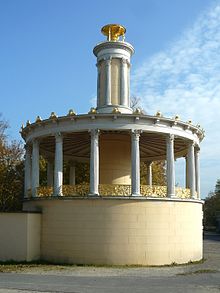Great curiosity
The Great Curiosity is a rotunda built as a tea pavilion with a view of the Glienicke Bridge , the Jungfernsee and the Berlin suburb of Potsdam.
Emergence
In 1824, Carl von Prussia acquired an estate on the island of Wannsee from the estate of Prince Hardenberg, whose park he increasingly expanded. After the Glienicke Bridge was built in 1834, the last extension to the bridgehead took place. In 1835 he had a round temple with 16 pillars built on a base, according to plans by the architect Karl Friedrich Schinkel , which separates the park from Glienicke Palace in today 's Glienicke Park . The viewing platform is crowned by a replica of the Lysikrates monument from Greece. With this, the architect copied the column structure and tried an archaeological reconstruction in the crowning, gold-colored shell. Were also added capitals of terracotta and a parapet grid and lots of small components from ancient reliefs, sculptures, Friesen and further.
Transfer
When the Glienicke Bridge was renewed in 1905, this led to a disruption of the viewpoints for the pavilion, which was then moved by about ten meters. This later made it possible to widen the road.
During the relocation, essential decorative elements such as the terracotta columns were only restored in a simpler form. In addition, the building was raised and a staircase was added.
Redevelopment
After intensive renovation including the removal of bomb damage from the Second World War , the pavilion was reopened to the public on June 7, 2009.
Web links
- The Unesco World Heritage Day attracted visitors with the “most beautiful arbor in Berlin” in: Potsdamer Latest News from June 8, 2009
- photos
- Entry in the Berlin state monument list: Great curiosity, part of the overall complex of Schloss Klein-Glienicke
Coordinates: 52 ° 24 '49 " N , 13 ° 5' 31.4" E

